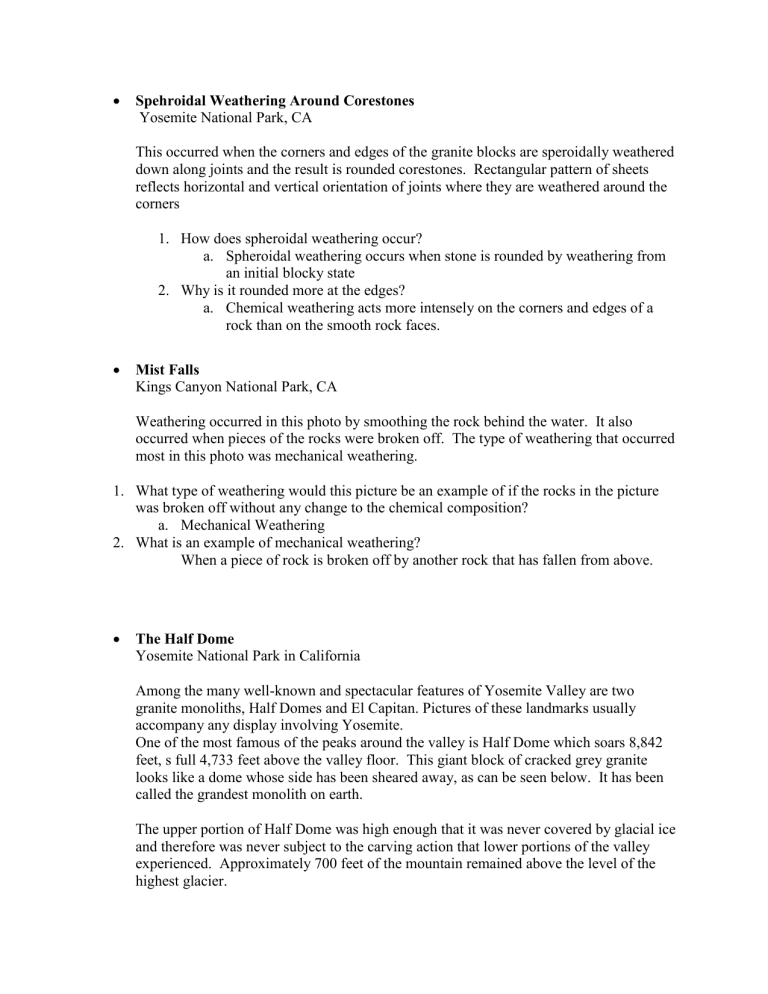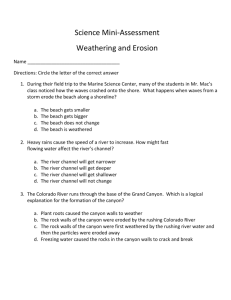Spehroidal Weathering Around Corestones Yosemite National Park

Spehroidal Weathering Around Corestones
Yosemite National Park, CA
This occurred when the corners and edges of the granite blocks are speroidally weathered down along joints and the result is rounded corestones. Rectangular pattern of sheets reflects horizontal and vertical orientation of joints where they are weathered around the corners
1.
How does spheroidal weathering occur? a.
Spheroidal weathering occurs when stone is rounded by weathering from an initial blocky state
2.
Why is it rounded more at the edges? a.
Chemical weathering acts more intensely on the corners and edges of a rock than on the smooth rock faces.
Mist Falls
Kings Canyon National Park, CA
Weathering occurred in this photo by smoothing the rock behind the water. It also occurred when pieces of the rocks were broken off. The type of weathering that occurred most in this photo was mechanical weathering.
1.
What type of weathering would this picture be an example of if the rocks in the picture was broken off without any change to the chemical composition? a.
Mechanical Weathering
2.
What is an example of mechanical weathering?
When a piece of rock is broken off by another rock that has fallen from above.
The Half Dome
Yosemite National Park in California
Among the many well-known and spectacular features of Yosemite Valley are two granite monoliths, Half Domes and El Capitan. Pictures of these landmarks usually accompany any display involving Yosemite.
One of the most famous of the peaks around the valley is Half Dome which soars 8,842 feet, s full 4,733 feet above the valley floor. This giant block of cracked grey granite looks like a dome whose side has been sheared away, as can be seen below. It has been called the grandest monolith on earth.
The upper portion of Half Dome was high enough that it was never covered by glacial ice and therefore was never subject to the carving action that lower portions of the valley experienced. Approximately 700 feet of the mountain remained above the level of the highest glacier.
Q :How did the Half Dome form?
A : Half Dome is the most famous landmark in Yosemite Valley, California. It’s very likely that half Dome never had another half, at least not one as well formed as this. The flat face overlooks Yosemite Valley, whose U-shaped cross section is attributed to glacial action. The dome itself reflects the general shape of an intrusion of granodiorite deep underground. As the intrusion became exposed by erosion, the change in pressure caused the rock to crack apart in thin shells, which fall off the sides and leave the mountain clean. The process is called exfoliation, and Half Dome is a classic exfoliation dome
Q :Which one of these pictures show an example of a complete dome?
A :there would be a picture of a dome that was completely rounded.
Devil’s Tower
Devil’s Tower National Monument, Wyoming
Molten rock is left behind after contracting and cracking forming columnar joints.
Columnar jointing are parallel, prismatic columns that are formed as a result of contraction as basaltic lava flows cools.
Q :How does columnar jointing occur?
A :Formed as a result of contracting as the basaltic lava flow cooled off
Q :Columnar jointing perpendicular or parallel to the structure/formation?
A : Parallel
Limestones Hoodoos in Byrce Canyon
Formed by two types of weathering o Frost Wedging o Acid Rain
There are over 200 freeze and thaw cycles a year. In the winter, snow melts and water seeps into cracks and at night it freezes. Water freezes and it expands by 10% and it slowly pries the rocks open to make them wider.. Rain also falls in Bryce Canyon. The little rain that falls is slightly acidic. Slowly the limestone is dissolved to create hoodoos over time.
Q :What two types of weathering form hoodoos
A :Frost wedging and acid rain
Q : what national park is most famous for hoodoos
A : Bryce Canyon
Badlands National Park, South Dakota
The South Dakota Badlands are made of sedimentary rocks that were weathered by rain water. In this area rain usually falls in heavy showers. As the water moves rapidly down the rock, it starts losing grains are rock particles.
Q :How do you get the crumbly surface?
A : The rocks are mostly made of volcanic ash which weathers into clay and then swells. After swelling it dries and shrinks. When it dries out, this is what makes the crumbly surface.
Q :What’s mostly found in these types of rock?
A :clay, fine-grained shales, siltstones, and volcanic ash.
Differential Weathering along vertical joint. Bryce Canyon, Utah
As vertical joints continued to weather down, they would encounter layers of rock that were more resistant than the previous ones. Lim-rich beds hardly weathered away while the lime-poor bed easily weathered away. These different weathering rates caused protrusions in the lime-rich layer and indentions in the weaker, lime-poor, this is called parallel grooving.
Q :what happens in parallel grooving?
A :Protrusions are caused in lime-rich layers and indentions are caused in lime-poor layers.
Q : Which layers of rock is more resistant to weathering? Lime- rich or lime-poor?
A : Lime-rich layers are more resistant while lime-poor layers easily weather away
Stalagmite
Linville Caverns, Blue Ridge National Park, Marion,NC
The caverns were created from water and carbon dioxide dissolving limestone and dolomite that formed the mountain.
Q :What exactly is a stalagmite?
A : A stalagmite is a pillar that is a deposit of rock that slowly grows from the ground up.
Q :What causes ripples?
A :The ripples in the rock are caused by the buildup of layers of limestone as the deterioration occurs. This causes the stacking ripples, relating to a pyramid formation.
Weathering by Wind
Grand Canyon, Arizona
The rock is being broke down by the wind blasting little grains of sand. The little grains of sand, break down the rock.
Q:What form of weathering caused this?
A:wind weathering
Q:What process works with weathering to take away the broken down rock?
A:Erosion
Bryce Canyon National Park
Shows brightly colored pinnacles, windowed walls, and spires
This shows the side of the canyon.
Snow freezes in the cracks and melts everyday opening the cracks 9% everytime.
Q:Was Bryce Canyon created over time?
A: Yes, it was
Q:What is the coloration of Bryce Canyon Rocks?
A: Pink/Orange






